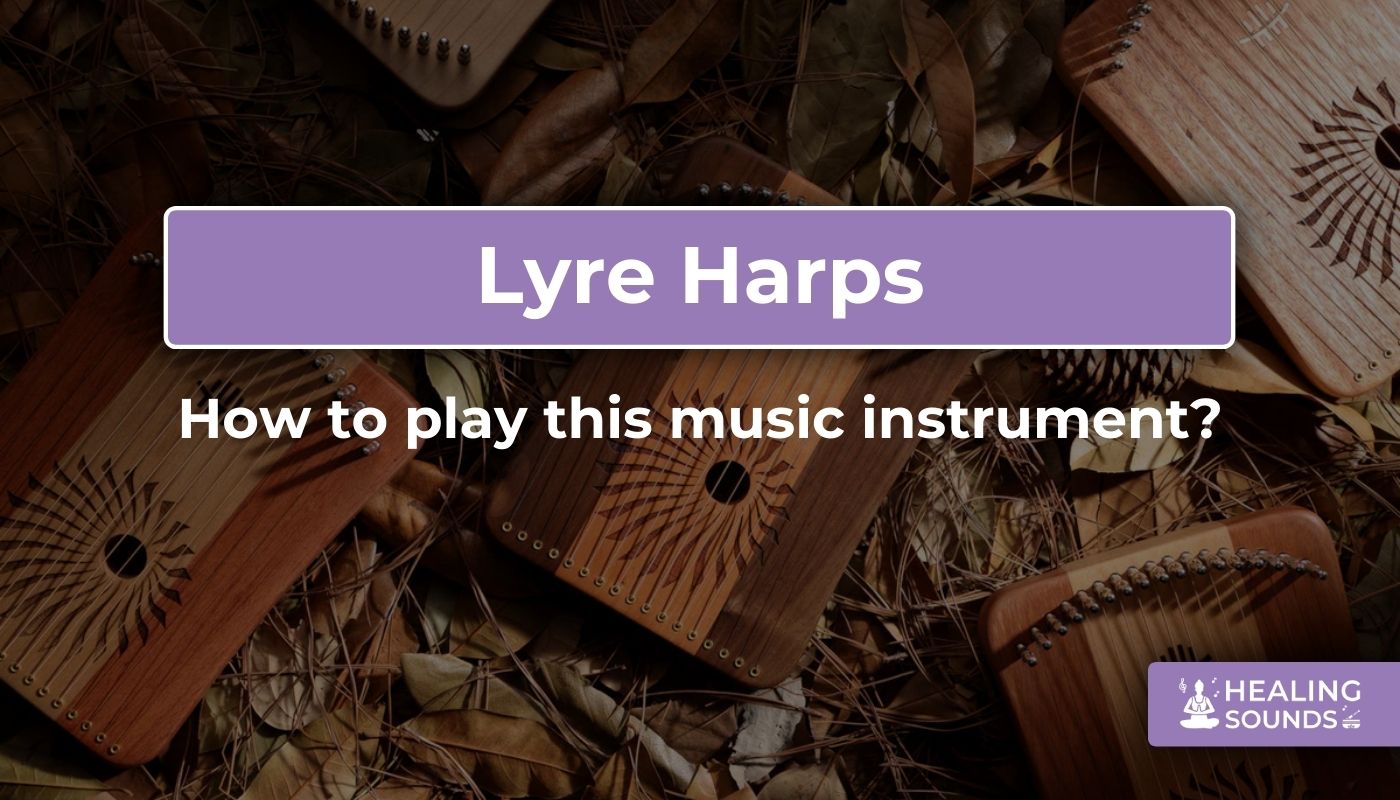The lyre instrument, with its ancient roots and ethereal melodies, offers a unique gateway into the world of music. Often associated with calming sounds and therapeutic qualities, learning how to play a lyre instrument can be a deeply rewarding experience, especially for those seeking relaxation and a gentle introduction to stringed instruments. If you're drawn to the enchanting allure of lyre music, this guide is designed for you, the curious beginner looking to embark on this musical journey.
We'll explore everything from the basics of the lyre's structure to practical steps for playing your first notes. Whether you have prior musical experience or are completely new, you'll find clear guidance to start playing lyre harp with confidence and uncover the soothing benefits this beautiful instrument offers.
What is a Lyre Instrument?
Before diving into how to play, let's understand the instrument itself. The lyre is a stringed instrument dating back to ancient Greece, known for its U-shaped frame, two arms, a crossbar, and strings running from the crossbar to a resonator body. Unlike larger harps, traditional lyres are often more compact and portable.
Modern lyres come in various sizes and string counts, but they retain the core design elements. The body, often made of wood, acts as a soundbox to amplify the vibrations of the plucked strings. Tuning pegs, located typically on the crossbar or frame, allow you to adjust the pitch of each string. Understanding this structure is the first step towards appreciating the nuances of lyre music.
Historically, the lyre was associated with storytelling, poetry, and healing rituals. You can learn more about its ancient origins from resources like the Metropolitan Museum of Art's collection.
Is it Easy to Play a Lyre?
Many beginners wonder if the lyre is difficult to learn. Compared to instruments like the guitar or violin, the lyre is often considered one of the more accessible stringed instruments, making it an excellent choice for newcomers to music.
Its typically open tuning (often pentatonic) means that even random plucking can produce harmonious sounds, which is incredibly encouraging for beginners. While mastering complex pieces takes practice, learning basic melodies and creating soothing sounds can be achieved relatively quickly, aligning perfectly with the goals of relaxation and personal enjoyment.
Choosing Your First Lyre Harp (Beginner Focus)
Selecting the right beginner lyre instrument is crucial for a positive learning experience. Key factors include the number of strings, size, weight, and materials.
For beginners, a lyre with 10 to 19 strings is often recommended. Fewer strings simplify the learning process, allowing you to focus on fundamental techniques like holding, plucking, and basic melodies without feeling overwhelmed. Consider a model specifically designed for comfort and ease of handling.

16-String Lyre Harp Instrument for Beginners
$56.90 $73.90
The Zani Mini 16-String Lyre Harp is perfect for beginners, offering ease of play and soothing sounds to start your musical journey.
Explore This Beginner LyreHow to Hold a Lyre for Beginners
Proper posture and holding technique are essential for comfortable playing and producing clear sound. Here’s how to hold a lyre typically:
- Positioning: Sit comfortably upright in a chair. You can rest the base of the lyre on your lap. Larger lyres might rest between your knees or be placed on a tabletop.
- Support: Use your non-dominant arm (usually the left) to support the lyre. Your forearm can gently cradle the side or back of the instrument's frame, keeping it stable without gripping too tightly.
- Angle: Angle the lyre slightly towards you so you can clearly see the strings and comfortably reach them with your dominant hand.
- Relaxation: Ensure your shoulders, arms, and wrists are relaxed. Tension can hinder your playing and cause discomfort over time.
Experiment to find the most natural and stable position for you and your specific lyre model.
How to Play a Lyre Instrument Step-by-Step
Ready to make some music? Here’s a step-by-step guide to start playing lyre harp:
1. Tuning Your Lyre
Before playing, your lyre must be in tune. Most lyres come with a tuning wrench. You can use a digital chromatic tuner or a tuning app on your smartphone.
Turn the tuning pegs slowly – small adjustments make a big difference. Clockwise typically raises the pitch, counter-clockwise lowers it (this can vary). Tune each string to its designated note (often indicated in the lyre's manual or common tuning charts like C major pentatonic). Consistent tuning is key for beautiful lyre music.
For a detailed guide, check out our article on tuning your lyre harp step by step.
2. Basic Plucking Techniques
The most common way to play the lyre is by plucking the strings with your fingers.
- Use the pads of your thumb and index finger (or other fingers) of your dominant hand.
- Keep your wrist relaxed and use gentle, consistent pressure to pluck each string.
- Experiment with plucking closer to the bridge (for a brighter sound) or further away (for a softer, warmer tone).
- Practice plucking individual strings clearly, one after another. Try ascending and descending scales.
Some players also use a plectrum (pick), which produces a different, often brighter sound. Try both methods to see what you prefer.
3. Playing Simple Melodies and Chords
Once comfortable with plucking individual notes, try simple melodies. Many traditional folk songs use simple scales that are easy to play on a pentatonic-tuned lyre.
You can also play chords by plucking multiple strings simultaneously or by strumming gently across a group of strings. Start with two-note combinations (dyads) and gradually move to three or more notes.
- Start slow and focus on clarity.
- Practice scales daily to build finger dexterity.
- Learn simple songs like "Mary Had a Little Lamb" or "Twinkle Twinkle Little Star".
- Listen carefully to the sounds you produce.
- Be patient and enjoy the process!
The Soothing Benefits of Playing Lyre Music
Beyond learning an instrument, playing the lyre offers significant benefits, particularly for relaxation and well-being – a core reason many beginners are drawn to it.
The gentle, resonant tones of the lyre instrument are inherently calming. The act of plucking strings and creating harmonious sounds can be a meditative practice, helping to reduce stress, quiet the mind, and foster a sense of peace. Engaging with lyre music stimulates creativity and provides a fulfilling form of self-expression.
Many find that incorporating lyre playing into their routine enhances mindfulness and provides a welcome escape from daily pressures. This connection between sound and healing is central to the experience Healing Sounds aims to provide.
Explore Beginner-Friendly Lyre Harps

17 String Rosewood Lyre Harp Instrument by Hluru
$59.90
$79.90
Crafted from Rosewood, this 17-string lyre offers a rich tone perfect for exploring relaxing lyre music. Learn more ➔

24 String Lyre Harp Instrument with Steel Strings
$89.90
$116.90
With 24 strings, this lyre offers a wider range for those ready to expand their playing lyre harp skills. Learn more ➔
Maintaining Your Lyre Instrument
Proper care will keep your lyre sounding beautiful for years to come. Regularly wipe the strings and body with a soft, dry cloth to remove dust and oils from your fingers. Store your lyre in a case or bag when not in use, protecting it from humidity changes and potential damage.
Check the tuning pegs occasionally to ensure they hold tension properly. If strings break, replace them with the correct gauge recommended for your specific lyre model. Consistent maintenance ensures your lyre instrument remains a joy to play.
Conclusion
Learning how to play a lyre instrument is an accessible and deeply satisfying pursuit, perfect for anyone seeking relaxation, creative expression, or a gentle introduction to music. From choosing the right beginner lyre instrument and learning how to hold it, to tuning and plucking your first melodies, the journey is filled with discovery and soothing sounds.
Remember that patience and consistent practice are key. Embrace the calming nature of lyre music and enjoy the process of learning. Healing Sounds is here to support your journey with quality instruments designed to inspire and facilitate healing through sound. Explore our collection and find the perfect lyre to begin your adventure.
Frequently Asked Questions about Playing the Lyre
Yes, the lyre is generally considered one of the easier string instruments to learn, especially for beginners. Its common tuning systems often create harmony easily, and basic plucking techniques can be picked up relatively quickly, making it very encouraging for new players seeking relaxation through music.
Rest the base of the lyre comfortably on your lap while sitting upright. Use your non-dominant forearm (usually left) to gently support the frame, keeping it stable. Angle it slightly towards you so you can see and reach the strings easily with your dominant (plucking) hand. Ensure your shoulders and arms are relaxed.
For many beginners, the lyre can be easier to start with than the guitar. Lyres often have fewer strings, simpler tuning, and don't require complex fingerings or chord shapes initially like the guitar does. The technique of plucking open strings to create melodies is often more immediately rewarding on a lyre.
A lyre with 10 to 19 strings is often ideal for beginners. This range provides enough notes to play simple melodies and chords without being overwhelming. Instruments like a 16-string lyre harp or a 17-string model offer a great starting point.
1. Choose & Tune: Select a beginner-friendly lyre and tune it using a tuner. 2. Hold Properly: Position the lyre comfortably on your lap, supporting it gently. 3. Learn Plucking: Practice plucking individual strings cleanly with your fingertips. 4. Play Scales: Practice ascending and descending notes. 5. Try Melodies: Learn simple songs or create your own patterns. 6. Practice Regularly: Consistency is key to improvement.

